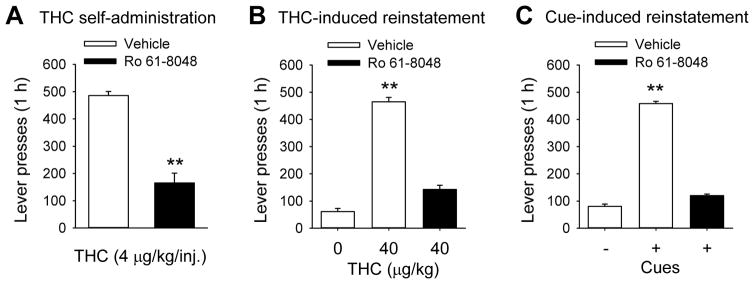Figure 2.
Effects of treatment with Ro 61-8048 in squirrel monkey models of relapse to cannabis seeking after a period of abstinence. Ro 61-8048 increases endogenous levels of kynurenic acid, a negative allosteric modulator of the α-7 nicotinic receptor. Monkeys had extensive experience self-administering THC under a schedule in which a green light indicated that THC (4 mcg/kg, IV) could be obtained by pressing a lever 10 times (fixed-ratio 10). Under these training conditions (maintenance), sessions were 1 h long, and each THC delivery was accompanied by a brief stimulus (amber light), followed by a 60-s timeout period (lights off) before the green light signaled that another injection could be obtained. (A) Treatment with Ro 61-8048 (20 mg/kg, IM) decreased THC self-administration under these maintenance conditions, with all cues and THC delivery maintained. (B) To model relapse induced by reexposure to THC, abstinence was first imposed by simply substituting vehicle for THC (but continuing to present cues) for several sessions prior to and including the test session. Responding decreased to low levels, but increased substantially when THC (40 mcg/kg, IV) was given automatically prior to the test session. Ro 61-8048 blocked this THC-induced reinstatement effect. (C) To model relapse induced by reexposure to cannabis-associated cues, abstinence was first induced by discontinuing all intravenous injections and all visual cue presentations. Then, to test for cue-induced reinstatement, the green light was presented, and every 10th response produced the amber light and an intravenous vehicle injection (to provide interoceptive injection-related cues), but no THC was given. These cues reinstated THC seeking, but their effect was blocked when monkeys were pretreated with Ro 61-8048. Thus, Ro 61-8048 blocked the direct reinforcing effects of THC, and it also blocked reinstatement by reexposure to THC or THC-related cues. These findings suggest that enhancing kynurenic acid levels might be a useful strategy for decreasing cannabis smoking and also for preventing relapse when users who have achieved abstinence are re-exposed to the drug or to environmental cues associated with the drug. Double asterisks indicate statistically significant differences between treatment and baseline (p < 0.01). Figure adapted from Justinova, Z., Mascia, P., Wu, H. Q., Secci, M. E., Redhi, G. H., Panlilio, L. V., … Goldberg, S. R. (2013). Reducing cannabinoid abuse and preventing relapse by enhancing endogenous brain levels of kynurenic acid. Nature Neuroscience, 16(11), 1652–1661. doi:10.1038/nn.3540 with permission.

